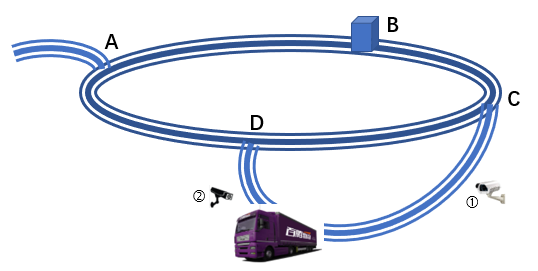前言

题解
睿抗机器人开发者大赛CAIP-编程技能赛-历年真题 汇总
2021 RoboCom 世界机器人开发者大赛-本科组(复赛)解题报告
感觉这个T1特别有意思,非典型题,着重推演下结论。
T2是一道玄学题,但是涉及一些优化技巧。
T3这类题,vp的价值并不大,但是符合睿抗的出题风格。
T4是睿抗特别喜欢的最短路径题,但是一来题目有坑点,二来真的太耗时间了,T_T。
7-1 冒险者分队
分值: 20分
思路:解方程组 + 中位数定律
题意省流:
三个数a, b, c 通过如下操作变为 d, e, f
- 选择某个数+40,其余两数-20
- 选择某个数-40,其余两数+20
求最小的操作步骤数,如不存在则返回-1
这类贪心题挺难,如何证明,以及写对挺难得。
前置论点:
- 某个数不可能同时存在+40,又-40的操作,因为两两抵消属于无用功,要满足最小步骤,必然只有一个操作方向
- a + b + c = d + e + f
令x1,x2,x3分别为a,b,c对应40的操作次数,(x1,x2,x3∈Z){令x_1,x_2,x_3分别为a, b, c 对应40的操作次数, (x_1, x_2, x_3 \in Z) }令x1,x2,x3分别为a,b,c对应40的操作次数,(x1,x2,x3∈Z)
- 若xk>0,说明+40操作xk次{若 x_k > 0, 说明 +40操作 x_k次}若xk>0,说明+40操作xk次
- 若xk<0,说明−40操作∣xk∣次{若 x_k < 0, 说明 -40操作 |x_k|次}若xk<0,说明−40操作∣xk∣次
构建对应的三元一次方程组,
{40x1−20x2−20x3=d−a=y1−20x1+40x2−20x3=e−b=y2−20x1−20x2+40x3=f−c=y3\left\{\begin{matrix} 40x_1 - 20x_2 - 20x_3 = d - a = y_1\\ -20x_1 + 40x_2 - 20x_3 = e - b = y_2\\ -20x_1 - 20x_2 + 40x_3 = f - c = y_3 \end{matrix}\right. ⎩⎨⎧40x1−20x2−20x3=d−a=y1−20x1+40x2−20x3=e−b=y2−20x1−20x2+40x3=f−c=y3
求f(x1,x2,x3)=∣x1∣+∣x2∣+∣x3∣最小求 f(x_1, x_2, x_3) = |x_1| + |x_2| + |x_3| 最小 求f(x1,x2,x3)=∣x1∣+∣x2∣+∣x3∣最小
该方程组的秩为2,没法解, 但是可以把x1,x2表示为x3的形态x_1, x_2表示为x_3的形态x1,x2表示为x3的形态
方程组进行变换为,可求得
{x1=(2y1+y2)/60+x3x2=(2y2+y1)/60+x3\left\{\begin{matrix} x_1 = (2y_1 + y_2) / 60 + x_3 \\ x_2 = (2y_2+y_1) / 60 + x_3 \end{matrix}\right. {x1=(2y1+y2)/60+x3x2=(2y2+y1)/60+x3
进而
f(x1,x2,x3)=∣x1∣+∣x2∣+∣x3∣f(x_1,x_2, x_3) = |x_1| + |x_2| + |x_3| f(x1,x2,x3)=∣x1∣+∣x2∣+∣x3∣
⇒f(x1,x2,x3)=∣x3+(2y1+y2)/60∣+∣x3+(2y2+y1)/60∣+∣x3∣\Rightarrow f(x_1,x_2, x_3) = |x_3+(2y_1 + y_2) / 60| + |x_3 + (2y_2+y_1) / 60| + |x_3| ⇒f(x1,x2,x3)=∣x3+(2y1+y2)/60∣+∣x3+(2y2+y1)/60∣+∣x3∣
⇒f(x1,x2,x3)=∣x3−z1∣+∣x3−z2∣+∣x3−z3∣\Rightarrow f(x_1,x_2, x_3) = |x_3- z_1| + |x_3 - z_2| + |x_3 - z_3| ⇒f(x1,x2,x3)=∣x3−z1∣+∣x3−z2∣+∣x3−z3∣
求这个得最小值,不就是 中位数定律 吗?
取 z1=−(2y1+y2)/60,z2=−(2y2+y1)/60,z3=0三个数的中间值,带入f(x1,x2,x3)即可{ z_1=-(2y_1 + y_2) / 60 , z_2=-(2y_2+y_1) / 60, z_3=0 } 三个数的中间值,带入f(x_1, x_2, x_3) 即可z1=−(2y1+y2)/60,z2=−(2y2+y1)/60,z3=0三个数的中间值,带入f(x1,x2,x3)即可
当然这边的额外条件是
保证 −(2y1+y2)/60,−(2y2+y1)/60-(2y_1 + y_2) / 60 , -(2y_2+y_1) / 60−(2y1+y2)/60,−(2y2+y1)/60 需为整数
#include <bits/stdc++.h>using namespace std;int64_t median(int64_t a, int64_t b, int64_t c, int64_t x) {return abs(x - a) + abs(x - b) + abs(x - c);
}int main() {int t;cin >> t;while (t-- > 0) {int64_t a, b, c;int64_t d, e, f;cin >> a >> b >> c;cin >> d >> e >> f;if (a + b + c != d + e + f) {cout << -1 << "\n";continue;}int64_t y1 = d - a;int64_t y2 = e - b;if ((2*y1 + y2) % 60 != 0 || (2 * y2 + y1) % 60 != 0) {cout << -1 << "\n";continue;}// 方程组求解int64_t z1 = (2 * y1 + y2) / 60;int64_t z2 = (2 * y2 + y1) / 60;vector<int64_t> tmp = {-z1, -z2, 0};sort(tmp.begin(), tmp.end());// 中位数定律int64_t res = median(-z1, -z2, 0, tmp[1]); // tmp[1]为中点cout << res << "\n";}return 0;
}
7-2 拼题A打卡奖励
思路: 0-1背包
时间复杂度O(N∗M)=O(365∗24∗60∗1000)=O(5∗108)O(N*M)=O(365*24*60*1000)=O(5*10^8)O(N∗M)=O(365∗24∗60∗1000)=O(5∗108)
#include <bits/stdc++.h>using namespace std;int main() {int n, M;cin >> n >> M;vector<int> arr(n), brr(n);for (int &x: arr) cin >> x;for (int &x: brr) cin >> x;vector<int> dp(M + 1);for (int i = 0; i < n; i++) {for (int j = M - arr[i]; j >= 0; j--) {dp[j+arr[i]] = max(dp[j+arr[i]], dp[j] + brr[i]);}}cout << *max_element(dp.begin(), dp.end()) << "\n";return 0;
}
纯数组的0-1背包,其实是可以直接冲的。
这题的玄就在玄在:
- g++提交,tle
- clang++提交, ac

那这题关键点在于什么呢?
- 每次打卡花费的时间为mi≤600m_i \le 600mi≤600
即总的容量为: Q=min(n∗600,M){Q = min(n*600, M)}Q=min(n∗600,M),时间复杂度变为 O(n∗Q)O(n*Q)O(n∗Q),存在收益
- 压缩容量遍历(尤其是早期)
可以对打卡时间从小到大排序,然后容量上限逐步提高
#include <bits/stdc++.h>using namespace std;int main() {int n, M;cin >> n >> M;vector<array<int,2>> cards(n);for (int i = 0; i < n; i++) {cin >> cards[i][0];}for (int i = 0; i < n; i++) {cin >> cards[i][1];}// 第一个优化点int Q = min(n * 600, M);vector<int> dp(Q + 1);// 第二个优化点, 按时间从小到大排序sort(cards.begin(), cards.end(), [](auto &a, auto &b) {return a[0] < b[0];});int tot = 0;for (int i = 0; i < n; i++) {int v = cards[i][0], w = cards[i][1];// 逐步放大范围tot = min(tot + v, Q);for (int j = tot - v; j >= 0; j--) {dp[j+v] = max(dp[j+v], dp[j] + w);}}cout << *max_element(dp.begin(), dp.end()) << "\n";return 0;
}
结果对比:

7-3 快递装箱
分值: 25分
思路: 建模+模拟
知识点: 双端队列
前置的知识点:
- 一个数组,整体右移一位,其实是需要借助一个临时变量来实现,这边也借助了这个技巧
根据题意,A,B,C,D点只能存一个包裹,但是A额外配置一个等待队里

包裹定义
struct Pack {int w = 0; // 快递/快递包的质量bool boxed = false; // 是否打包
};
这里面有歧义的地方
D点位 在已经没有货物过来了,则停止当前的装箱工作,做自检
如何解读这个呢?
- 从D点的角度出发,C点没有货物过来
- 所有快递都在传输带上了,最后一个新快递刚到A点,激活该策略
- 所有快递都在传输带上了,其最后一个快递要么出列,要么重新回到A点,激活该策略
这题,完全没说明这点,而且有case解说,但是没有消除歧义。
目前按2,3去解释,能完全AC,但是两者在特定case下,结果又不一样。
#include <bits/stdc++.h>using namespace std;struct Pack {int w = 0;bool boxed = false; // boxed
};int main() {int n, wmax, w1, w2;cin >> n >> wmax >> w1 >> w2;vector<int> arr(n);for (int &x: arr) cin >> x;int ans1 = 0, ans2 = 0;deque<Pack> A;Pack a, b, c, d;bool ae = false, be = false, ce = false, de = false;auto loop_event = [&](bool flag, int x) -> bool {bool update = false;Pack tmpA;bool tmpAe = false;if (flag) {if (!A.empty()) {Pack top = A.front();if (top.w + x <= wmax) {top.w += x;tmpA = top;tmpAe = true;A.pop_front();} else {tmpA = {x, false}; tmpAe = true;}} else {tmpA = {x, false}; tmpAe = true;}} else {if (!A.empty()) {tmpA = A.front(); A.pop_front();tmpAe = true;}}if (de) {if (ce) {if (!c.boxed && d.w + c.w <= wmax) {d.w += c.w;} else {if (d.w > w2) {ans2++;} else {A.push_back(d);}d = c;d.boxed = true;}ce = false;} else {if (!flag) {// 如果没有新货源,则需要自检并打包/推进,不允许等待if (d.w > w2) {ans2++;update = true;} else {A.push_back(d);}de = false;}}} else {if (ce) {d = c;de = true;d.boxed = true;ce = false;} else {de = false;}}if (be) {if (b.w > w2) {ans1++;update = true;ce = false;} else {c = b;ce = true;}be = false;} else {ce = false;}if (ae) {b = a;be = true;if (b.w > w1) {b.boxed = true;}ae = false;} else {be = false;}a = tmpA;ae = tmpAe;return update;};for (int x: arr) {loop_event(true, x);}int loop = n - ans1 - ans2 + 4;while (loop-- > 0) {if (loop_event(false, -1)) {loop = n - ans1 - ans2 + 4;}}vector<int> left;while (!A.empty()) {left.push_back(A.front().w);A.pop_front();}if (ae) left.push_back(a.w);if (be) left.push_back(b.w);if (ce) left.push_back(c.w);if (de) left.push_back(d.w);sort(left.begin(), left.end());cout << ans1 << " " << ans2 << " " << left.size() << "\n";int mz = left.size();if (mz == 0) cout << "None\n";else {for (int i = 0; i < mz; i++) {cout << left[i] << " \n"[i == mz - 1];}}return 0;
}期间参考了 小哈里 博客:
2021 RoboCom 世界机器人开发者大赛-本科组(复赛)-T3代码
感觉用四个队列,代码更简洁些,两者另一个差异:规则解读上D点,没有新货物来时, D点的货物该怎么操作。
构造一个特定的case
输入:
5 100 50 80
60 88 88 20 61输出(按2解释)
2 0 3
20 60 61
输出(按3解释)
2 0 2
61 80
两份代码都能AC,但是特定case输出不一样,睿抗数据还是弱了。
毫无疑问,这是一道好题,但是睿抗的出题,总会整一些歧义点,然后让你拿不了满分,同时使得你陷入到处找茬/猜猜乐的窘境。
7-4 塔防游戏
分值: 30分
思路: dijkstra 板子题
需要逆向从目标点出发,到达僵尸所在地,然后在按时间模拟
注意点:
- 只要击毁大本营就是胜利,不需要达到大本营地
- 只要击毁堡垒,才能到达该格子,前后顺序不能相反
- 当3个僵尸同时攻打某个防御值为2的堡垒,该堡垒消失的同时,3个僵尸都会被扣1滴血 出处参考
- 每个僵尸军团不能合并,需要维护其独立性
- 路径规划
- 单纯的dijkstra板子即可
时间复杂度为O(n∗m∗log(n∗m))O(n*m*log(n*m))O(n∗m∗log(n∗m))
- 路线模拟
- 每个军团按单位时间挪动一个位子
时间复杂度为O(T∗2∗(n+m))O(T * 2 * (n + m))O(T∗2∗(n+m))
#include <bits/stdc++.h>using namespace std;const int inf = 1e8;struct ST {int w = inf;int s = 0;bool operator<(const ST &o) const {if (w != o.w) return w < o.w;return s < o.s;}
};struct Step {int y, x;ST st;bool operator<(const Step& o) const {return o.st < st;}
};int main() {ios::sync_with_stdio(false);cin.tie(nullptr);cout.tie(nullptr);int n, m, T;cin >> n >> m >> T;vector<vector<int>> g(n + 2, vector<int>(m + 2));vector<array<int, 3>> js;int ty = -1, tx = -1;for (int i = 0; i <= n + 1; i++) {for (int j = 0; j <= m + 1; j++) {cin >> g[i][j];if (g[i][j] < 0) {ty = i; tx = j;g[i][j] = -g[i][j];} else if ((i == 0 || i == n + 1) && j != 0 && j != m + 1 && g[i][j] > 0) {js.push_back({i, j, g[i][j]});g[i][j] = 0;} else if (i != 0 && i != n + 1 && (j == 0 || j == m + 1) && g[i][j] > 0) {js.push_back({i, j, g[i][j]});g[i][j] = 0;} else if (i == 0 || j == 0 || i == n + 1 || j == m + 1) {g[i][j] = inf;}}}// 逆向dijkstravector<vector<ST>> dp(n + 2, vector<ST>(m + 2));vector<vector<int>> source(n + 2, vector<int>(m + 2, -1));priority_queue<Step, vector<Step>> pq;pq.push({ty, tx, {0, 0}});dp[ty][tx] = {0, 0};int dirs[4][2] = {{-1, 0}, {1, 0}, {0, -1}, {0, 1}};while (!pq.empty()) {Step step = pq.top(); pq.pop();int y = step.y, x = step.x;if (dp[y][x] < step.st) continue;for (int i = 0; i < 4; i++) {int ny = y + dirs[i][0];int nx = x + dirs[i][1];if (ny >= 0 && ny <= n + 1 && nx >= 0 && nx <= m + 1) {ST tmp = {dp[y][x].w + g[ny][nx], dp[y][x].s + 1 + g[ny][nx]};if (tmp < dp[ny][nx]) {dp[ny][nx] = tmp;if (ny != 0 && ny != n + 1 && nx != 0 && nx != m + 1) pq.push(Step{ny, nx, tmp});source[ny][nx] = y * (m + 2) + x;}}}}while (T-- > 0) {set<array<int, 2>> hash;vector<array<int, 3>> njs;for (auto &[y, x, w]: js) {int d = source[y][x];int ny = d / (m + 2), nx = d % (m + 2);if (g[ny][nx] > 0) {g[ny][nx]--;hash.insert({ny, nx});if (w > 1) njs.push_back({y, x, w - 1});} else if (hash.count({ny, nx}) != 0) {if (w > 1) njs.push_back({y, x, w - 1});} else {njs.push_back({ny, nx, w});}}if (g[ty][tx] <= 0) break;js.swap(njs);}for (int i = 1; i <= n; i++) {for (int j = 1; j <= m; j++) {if (i == ty && j == tx) {cout << min(0, -g[i][j]) << " \n"[j == m];} else {cout << g[i][j] << " \n"[j == m];}}}if (g[ty][tx] <= 0) {cout << "Game Over\n";}return 0;
}
写在最后


- 首页数据业务视图)











![[学习] 笛卡尔坐标系的任意移动与旋转详解](http://pic.xiahunao.cn/[学习] 笛卡尔坐标系的任意移动与旋转详解)





